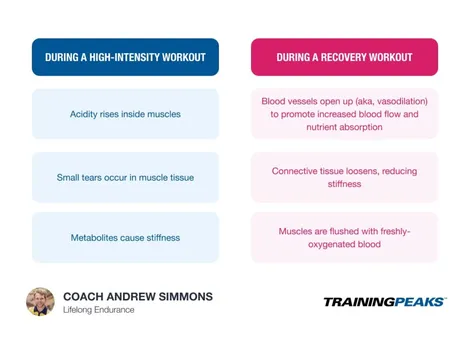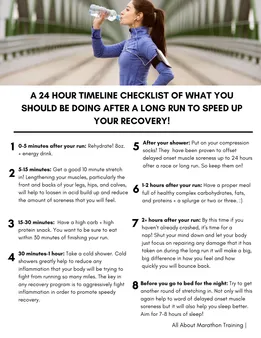Table of Contents
In the world of running, recovery is just as important as the run itself. A well-executed recovery run can help you bounce back faster, reduce muscle soreness, and improve your overall performance. Whether you're a seasoned runner or just starting out, understanding How to do a recovery run is essential for unlocking your full potential. At Kizworld, we're dedicated to providing runners with the knowledge and tools they need to succeed. In this comprehensive guide, we'll delve into the art of recovery runs, exploring their benefits, techniques, and common pitfalls to avoid. Get ready to optimize your post-workout recovery and take your running to the next level.
How to Do a Recovery Run That Actually Helps You Recover
I. What Is a Recovery Run?
What Is a Recovery Run?
A recovery run is a low-intensity run that you do after a hard workout or race. The purpose of a recovery run is to help your body recover from the stress of the hard effort and to promote muscle repair and growth. Recovery runs are typically done at a pace that is about 60-70% of your maximum heart rate.
Benefits of Recovery Runs
- Promote muscle repair and growth
- Reduce muscle soreness
- Improve circulation
- Flush out metabolic waste products
- Help you sleep better
- Boost your mood
Recovery runs are an important part of any runner's training plan. By taking the time to recover properly, you can improve your performance and reduce your risk of injury.
II. How to Do a Recovery Run
- Choose the Right Time: The best time to do a recovery run is within 24-48 hours after a hard workout or race.
- Keep It Easy: Recovery runs should be done at a slow, easy pace. Aim for a pace that is about 60-70% of your maximum heart rate.
- Focus on Form: Pay attention to your form while you're running. Make sure you're running with a relaxed stride and that you're not overstriding.
- Listen to Your Body: If you're feeling tired or sore, don't push yourself too hard. Take a break or walk for a few minutes.
- Stay Hydrated: Drink plenty of water before, during, and after your recovery run. Staying hydrated will help your body recover more quickly.
- Refuel Afterward: Eat a healthy meal or snack within 30 minutes of finishing your recovery run. This will help your body replenish its glycogen stores and promote muscle repair.
Common Mistakes to Avoid
- Running too fast: Recovery runs should be done at a slow, easy pace. If you run too fast, you'll defeat the purpose of the run and you may actually make yourself more tired.
- Running too long: Recovery runs should be short and sweet. Aim for a run that lasts no more than 30-45 minutes.
- Ignoring your body: If you're feeling tired or sore, don't push yourself too hard. Take a break or walk for a few minutes.
- Not staying hydrated: Staying hydrated is important for overall health and recovery. Make sure you drink plenty of water before, during, and after your recovery run.
- Not refueling afterward: Eating a healthy meal or snack within 30 minutes of finishing your recovery run will help your body replenish its glycogen stores and promote muscle repair.
By following these tips, you can make the most of your recovery runs and improve your overall running performance.
III. Conclusion
Recovery runs are an essential part of any runner's training plan. By taking the time to recover properly, you can improve your performance and reduce your risk of injury. So next time you're feeling tired or sore after a hard workout or race, don't skip your recovery run. Just lace up your shoes and head out for a slow, easy jog. Your body will thank you for it.
If you're looking for more information on how to improve your running, check out our other articles on how to improve your speed, how to improve your endurance, and how to improve your form.
IV. Benefits of Going for a Recovery Run
Benefits of Going for a Recovery Run
Incorporating recovery runs into your routine offers a multitude of benefits that can enhance your overall running performance and well-being. Here are some key advantages of recovery runs:
- Reduced Muscle Soreness: Recovery runs promote blood flow to the muscles, aiding in the removal of metabolic waste products and reducing muscle soreness.
- Improved Muscle Recovery: By increasing blood flow, recovery runs facilitate the delivery of oxygen and nutrients to the muscles, accelerating the recovery process.
- Enhanced Flexibility: Recovery runs help maintain muscle flexibility, reducing the risk of injuries and improving overall mobility.
- Improved Cardiovascular Health: Recovery runs contribute to a stronger cardiovascular system by maintaining heart health and improving overall fitness.
- Mental Relaxation: Recovery runs provide an opportunity for mental relaxation and stress relief, promoting a sense of well-being and reducing the risk of burnout.
To maximize the benefits of recovery runs, it's essential to keep the pace easy and focus on maintaining a comfortable effort. Additionally, staying hydrated and refueling with carbohydrates and protein after the run is crucial for optimal recovery.
By incorporating recovery runs into your routine, you can optimize your training, reduce the risk of injuries, and enhance your overall running experience. Learn more about how to do a recovery run effectively and unlock the full potential of this essential training component.
V. Common Mistakes to Avoid
While recovery runs offer numerous benefits, there are a few common mistakes that runners should avoid to ensure a safe and effective recovery:
- Pushing Too Hard: Recovery runs should be easy and relaxed, avoiding high-intensity efforts that can hinder the recovery process.
- Neglecting Hydration: Staying hydrated is crucial during recovery runs to replenish fluids lost through sweat and support the body's recovery processes.
- Skipping Refueling: After a recovery run, it's essential to refuel with a balanced meal or snack containing carbohydrates and protein to aid in muscle recovery and replenish energy stores.
- Ignoring Rest: Adequate rest is essential for recovery. Avoid back-to-back hard workouts and allow sufficient time for the body to recover and rebuild.
- Ignoring Pain: If you experience persistent pain or discomfort during a recovery run, it's important to listen to your body and take a break. Pushing through pain can lead to injuries.
By avoiding these common mistakes, you can optimize your recovery runs and reap the full benefits they offer. Remember, recovery is an integral part of the training process, and prioritizing it will help you become a stronger and more resilient runner.
VI. How to Do a Recovery Run
How to Do a Recovery Run
Following an intense workout, a recovery run can promote muscle repair, reduce soreness, and enhance overall performance. Here's a detailed guide to help you get the most out of your recovery runs:
- Choose the Right Time: Plan your recovery run for 24 to 72 hours after a hard workout. This allows your body ample time to recover and replenish energy stores.
- Keep It Easy: During a recovery run, maintain a conversational pace. Aim for a pace that feels comfortable and allows you to hold a conversation without gasping for air.
This infographic illustrates the key differences between recovery runs and regular runs:
Characteristic | Recovery Run | Regular Run |
Pace | Conversational, easy effort | Faster, pushing your limits |
Distance | Shorter, typically 3-5 miles | Longer, depending on training goals |
Duration | 30-60 minutes | 60+ minutes |
Purpose | Aid recovery, reduce muscle soreness | Improve fitness, burn calories |
- Focus on Form: While the pace is easy, maintain proper running form. This includes good posture, a midfoot strike, and a relaxed stride. Learn more about improving your running form here.
- Listen to Your Body: Pay attention to how your body is responding during the run. If you feel any unusual pain or discomfort, stop and rest.
Here are some common mistakes to avoid during a recovery run:
- Running Too Fast: The purpose of a recovery run is to aid recovery, not push your limits. Avoid the temptation to increase your pace.
- Running Too Long: Keep your recovery runs short and focused. Extended runs can hinder the recovery process.
- Ignoring Proper Form: Maintaining good form during a recovery run is crucial to prevent injuries. Avoid slouching or taking sloppy steps.
- Neglecting Hydration: Even on easy runs, staying hydrated is essential. Carry water or a sports drink to replenish fluids lost through sweat.
For an optimal recovery experience, follow these post-run tips:
- Refuel Afterward: Within 30 minutes of completing your run, consume a combination of carbohydrates and protein to aid muscle recovery. Explore our guide to the best post-workout foods and snacks.
- Stretch: Engage in dynamic stretching before your run and static stretching afterward to promote flexibility and reduce muscle tightness.
Incorporating recovery runs into your training routine can significantly enhance your overall performance and promote a healthier running lifestyle. Remember, recovery is just as important as the run itself, so make it a priority!
VII. Tips & Tricks for a Successful Recovery Run
Keep It Light and Easy
- Organize a plan: Decide on your run path and span offhand.
- Maintain moderate momentum: Keep a light pace to ensure a wholesome recovery.
- Listen to your body: Monitor your energy and adjust run tempo if required.
Related: How to Find the Best Running Routes and Trails
Prioritize Proper Breathing
- Relax and breathe naturally: Don't overthink it, just let the breath flow without strain.
- Concentrate on inhalation quality: Focus on deep and complete breaths rather than striving for pace.
Related: The Benefits of Running for Health and Wellness
Don't Forget to Refuel
- Nourish yourself during a run: Prepare snacks prior to your run to avoid hunger.
- Preserve energy levels: Opt for nutritious, quick-digesting foods for optimal results.
Related: The Best Running Nutrition and Hydration
Hydration is Key
- Bring water on your run: Staying hydrated is vital for a restorative session.
- Time it right: Take small sips of water at intervals rather than gulping large amounts.
Related: The Best Running Shoes and Socks
Pay Attention to Your Body
- Mind your muscles and joints: Be cognizant of potential pains and adjusts your run if necessary.
- When in doubt, walk: Walking amid your run is acceptable and beneficial for recovery.
Related: The Most Common Running Injuries and How to Prevent Them
Stretching for Recovery
- Stretch major muscle groups: Dedicate 5-10 minutes to stretching your quads, hamstrings, calves, and hip flexors.
- Prioritize dynamic stretches: Incorporate movement-based stretches for better recovery outcomes.
Related: The Best Running Exercises and Workouts
Avoid Alcohol and Heavy Meals
- Refrain from alcohol post-run: Alcohol impedes recovery and may induce dehydration.
- Opt for balanced nutrition: Choose a wholesome meal rather than indulging in high-fat or sugary foods.
Related: The Best Running Apps and Websites
Don't Push Too Hard
- Avoid overdoing it: Your recovery run isn't meant for max effort, keep it chill.
- Focus on enjoying the run: Make it a relaxing time instead of a strenuous workout.
Related: How to Train Like a Runner
Stay Safe and Visible
- Plan safe routes and keep aware of your surroundings.
- Utilize appropriate running gear, including reflective vests and nighttime lighting.